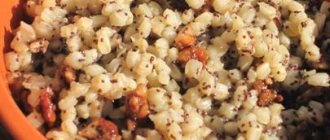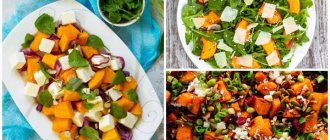Dear friends! During the days of Great Lent, we prepared Lenten dishes according to the recipes of Maxim Syrnikov.
Maxim Syrnikov is a researcher and expert of Russian cuisine, author of cookbooks, popular TV presenter and online culinary blogger, famous chef.
Maxim Pavlovich Syrnikov comes from St. Petersburg, from a family of scientists. There he graduated from school and the philological faculty of the Institute of Culture. His grandfather and great-grandfather on his father’s side were cheese makers; in those days they were called syrniki. This is where the tasty surname came from.
During his school years, the boy was already interested in cooking, and instead of fairy tales, he enthusiastically read books on cooking. At the age of 11, he thoroughly studied the works of V.V. Pokhlebkin, and by the age of 15 he already had his own collection of spices. But his parents didn’t take it seriously, so the guy went to study as a philologist. After college, he served in the navy, then worked as a meat cutter. But the dream of becoming a chef remained a dream.
In the 90s, his St. Petersburg friends organized pizza delivery throughout the city and invited Syrnikov to their place, where he began to develop the recipe. In 2000, he actively maintained his culinary blog and achieved enormous popularity on the Internet. Thanks to this, he began to be invited to restaurants in different cities to develop menus and provide consulting.
In all his trips around our country and expeditions, he was always interested in traditional Russian cuisine, ancient and long-forgotten recipes of our ancestors. He publishes the collected information and recipes of true Old Russian cuisine in his books. All of them are beautifully illustrated, complemented by stories about certain dishes. Moreover, the author is interested not only in “ceremonial” food, such as fried swans, but in the everyday food of our grandmothers and great-grandmothers, simple and unsophisticated.
This is what the list of his books looks like: “Real Russian Food”, “Baking in Russian”, “Cooking in Russian Every Day”, “Preparations in Russian”, “Holidays in Russian”, “Real Russian Holidays”. Judging by the titles of the books, you can guess what dishes they are talking about. But one thing they have in common is the presence of amazing recipes that were long forgotten by our population.
His books are not dry collections of Russian recipes. They are written in sincere language, and Syrnikov knows how to tell stories, he knows a lot of all kinds of jokes and jokes. In addition, it can easily dispel some myths and misconceptions regarding Russian dishes and immerse us in the atmosphere of long-ago childhood holidays spent visiting my grandmother in the village.
He collected ancient recipes from remote villages and restored them bit by bit. I met with old people and wrote down their stories. Then I studied from old books and prepared each dish myself. Therefore, it gives not only the exact ratio of ingredients, but also some details that distinguish each dish from other similar ones. And he does not adapt ancient recipes to our modern conditions. This right is granted to housewives.
According to Maxim Pavlovich, as long as we cook cabbage soup and prepare okroshka, bake rye bread and ferment cabbage for the winter, salt mushrooms and need kvass, the Russian people themselves will exist. But if we lose our traditional cuisine, we can quietly get lost among the faceless herd of fast food civilization.
Now he is the chef of the Dobryanka restaurant chain in Novosibirsk, Tomsk, Krasnoyarsk, Omsk, Tver and the brand chef of the restaurant complex in Vladivostok. M.P. Syrnikov acts as a menu consultant when opening large restaurants of Russian cuisine in Moscow, St. Petersburg, Chelyabinsk and other cities. He enjoys giving master classes on YouTube on cooking Russian dishes.
On the Spas TV channel, Maxim Pavlovich hosts the culinary program “Monastery Kitchen,” where he cooks in front of the camera or invites famous guests to do so. Moreover, not only lenten dishes are prepared here, as you might think based on the name of the program. Here you can learn to create real culinary masterpieces! The program is very intelligent, recipes are spoken orally and shown on the screen.
But on the Spas channel on Saturdays during the daytime you can watch another program hosted by M.P. Syrnikov. It's called "Russian Lunch". Not only is a real Russian dinner prepared there, but it also tells a lot of interesting things about forgotten traditions and ancient methods of cooking.
Another passion of our today's hero is fishing. Therefore, with their like-minded people, they organized the gastronomic culinary festival “Seligersky Rybnik”. And in the Tver region, a culinary festival “At Pozharsky’s in Torzhok” is regularly held, where he is a member of the jury and a permanent participant.
This is how he is, Maxim Syrnikov, who considers himself a deeply religious person, and therefore he never celebrates the arrival of the New Year. Usually he goes to the monastery, away from the New Year's bustle, fireworks and firecrackers. Only Christmas is celebrated in January. In addition to Russian cuisine, she loves Caucasian cuisine.
We have selected two Lenten recipes from Maxim Syrnikov. These are “Bishop Cutlets” and “Lenten Brine Cookies”. Dishes are rare, gone from our reality. Perhaps many of our guests have never tried this.
Lenten recipes: homemade Lenten noodles.
2-3 hours before cooking, mushrooms should be soaked in cold water.
Make broth from pre-soaked mushrooms and roots. Remove the mushrooms and cut into thin strips. Boil the noodles until tender in a small part of the resulting broth, along with the mushrooms. Place everything on a sieve.
Bring the remaining, most of the broth to a boil and add noodles and mushrooms to it.
Before serving, add a spoonful of vegetable oil. Sprinkle with chopped herbs.
Strict fasting
A consequence of the ancient, more strict rules of fasting is the order of Lenten worship: on Monday, Tuesday and Thursday the Liturgy of the Pre-Consecrated Gifts is not served, since the partaking of the Holy Gifts is inevitable on them. (According to strict rules, complete fasting was required during the first five, rather than two, days of fasting).
One can also add that modern people often go to riskier restrictions on their flesh, not for religious reasons. Each person can feel the essence of fasting in its entirety only by experiencing it for himself.
In one of the books about Lent at the beginning of our century, the author cites the story of a pious man from the laity of the intelligentsia, who decided to fast according to all the strict rules. The experience this man gained shocked his soul with completely unexpected results.
You can get used to everything. You can get used to eating a piece of bread and a glass of water a day. Little by little the narrator also got used to his meager meal. It took relatively little time for this: no more than two weeks into his strict fast, he felt that this fast was no longer burdening him.
Comparing himself now with his former self, he could notice one change. Now that playful, self-satisfied mood of a well-fed person, which so unpleasantly strikes others, never appeared in him.
This is the mood in which a person surrenders to the sweet languor of peace, doing nothing, light reading, etc. He now felt completely incapable of all this.
It seemed to him that his body now did not have those extra juices that give rise to this complacency.
It seemed to him that he had just enough vitality juice left to make his body obey his soul. He now understood why St. Ascetics considered fasting the first condition of the so-called “spiritual work.” He became convinced that fasting actually “thinned” the body and gave wings to the soul.
His eyes were opened to himself. He made a correct assessment of himself, and this assessment turned out to be low. The desire to remake myself became the main thing in my soul.
True, passions did not die in her soul: they made her feel just as keenly as before. But the center of gravity of mental life has shifted from these passions to what is divine and heavenly in the soul. It’s as if the whole worldview has changed.”
The story ends with a description of one minute that rewarded the faster for all his hardships, which was never repeated in his life again - she was so blessed!
This happened on Holy Week, during the service of Matins on Holy Saturday. For the first time, real tears of tenderness visited him, those sweet tears of delight that he knew about only from the books of asceticism. The verse of the so-called “Article of First Praise” was read in the temple:
Only now the narrator realized the depth and beauty of this place of duty, “. The love of Christ depicted here and the depth of human fall, which lured God Himself into hell, appeared to the consciousness in such brightness and strength, so touched the soul that it was impossible to hold back tears.”
Radish is a consolation for a fasting person, a traditional Russian snack.
In the old days they said that during Lent even the church bells sang: “Horseradish, radish, radish, horseradish!”
Russian black radish is an excellent root vegetable for making Lenten appetizers.
For example, this one:
One medium radish
One sour apple (antonovka is best)
Five tablespoons of vegetable oil
Two tablespoons of honey
salt to taste.
Wash the peeled radish and grate it, also grate the apple. Stir, season with honey and butter, salt.
Maxim Syrnikov today
In February 2021, interesting information appears on the Internet that the famous swindler from Russian cuisine has finally gotten away with it. In court, cook Maxim Syrnikov was found to be a liar and slanderer. Many fans wondered why the popular chef was fined for such sins.
Olga and Pavel Syutkin
Olga and Pavel Syutkin, educated historians, discovered historical fraud and lies in Syrnikov’s published materials. They could not ignore such impudent lies, expressing their opinion about the works of the “great connoisseur of Russian cuisine.” To which we received an unexpectedly quick response.
On his Facebook page, the enterprising guest chef published accusations against the Syutkins that they were simply “enemies of traditional Russian cuisine,” and then indecent insults were poured into their address. Syrnikov even suggested that “this scum, Pavel Syutkin, considers him a direct competitor and is even going to kill him.”
The Syutkins decided to deal with Syrnikov like gentlemen, that is, using legal methods, and filed a statement of claim in court. In March 2019, the St. Petersburg court issued a final ruling, according to which the cook was recognized as a liar and slanderer. The final touch, the court imposed a fine of 200 thousand rubles on the “hero of Russian cuisine.” It is unknown how such an incident will affect the future professional career of the famous brand chef.
The biography of Maxim Syrnikov, a connoisseur of original Russian cuisine, will be replenished with interesting facts and unique recipes. Today, the famous culinary specialist is invited to various TV channels to participate in popular projects, including “Rules of Life” on the Culture TV channel and “Taste” on OTV.
Lenten recipes: mushroom hodgepodge in a frying pan
Mushroom solyanka is a lean dish, but tasty and satisfying. To prepare it, we will need salted mushrooms - it is better if they are white or yellow milk mushrooms. Bitters, volushki, saffron milk caps, and salted boletus mushrooms are also suitable.
This is not a soup or a stew - the finished dish will be juicy, but without excess liquid.
Salted mushrooms - 2 cups
Fresh or pickled cabbage - 500 g
Two bulbs
Four tablespoons of vegetable oil
Cut the mushrooms into strips and fry with onions in a frying pan. Add a spoonful of flour and fry a little more, stirring with a spatula.
Simmer the cabbage until soft, squeeze.
Place the solyanka in a frying pan without a handle: a layer of cabbage, a layer of mushrooms and cabbage on top. Add some brine or water to the pan.
Bake in the oven at 180 C until the top layer is browned.
Lenten recipes: Oatmeal jelly
Kissels have been known in Russia for a long time. Traditional Russian jelly has little in common with the sweet, starchy drink. Most often it is made from brewed flour or cereal.
There are two main ways to prepare such jelly - with short-term fermentation and without fermentation.
Try this, the simplest method.
Oatmeal - two glasses
Water - three glasses
Three tablespoons of granulated sugar
Juice and zest of half a lemon
Pour cold water over the flakes and leave for several hours.
Strain the resulting infusion and squeeze through a sieve into a saucepan. Add sugar, lemon juice and zest to the oatmeal infusion.
The jelly is cooked on the stove, stirring constantly until thickened.
The finished hot jelly is poured into a pre-cooled form and placed in the cold until completely thickened. Serve the jelly out of the mold onto a dish, topped with poppy seed or almond milk, honey or jam.
Private life
The personal life of the popular chef and culinary specialist Maxim Syrnikov is a closed topic for the public. In none of his interviews does he give complete information, only general information. Marital status: Married. The wife fully shares her husband’s hobbies in life, but is not eager to join his business. There are children: a daughter and a son.
Maxim Syrnikov with his son
This year my daughter turns 29 years old, and my son turns 13. That’s all we know today. Family, wife, daughter and son, their photos do not appear on any Instagram or Facebook page, although Maxim is a very active user of social networks.
Second courses
“If, by fasting physically, we become entangled in the most destructive passions of the soul, then the exhaustion of the flesh will not bring us any benefit, when at the same time we remain defiled in the most precious part of our nature, which, in fact, becomes the dwelling of the Holy Spirit.”
Venerable Cassian the Roman
SECOND DISHES PREPARED WITHOUT OIL
Boiled potatoes with nuts
500 g
potatoes, 1 onion, 150 g peeled walnuts, 1 - 2 cloves of garlic, 2 sprigs of cilantro, parsley or dill, wine vinegar, red pepper, salt to taste.
Boil well-washed potatoes with skins, cool, peel and cut into cubes. Crush peeled walnuts, garlic, red pepper and cilantro with salt.
Add wine vinegar and chopped onions to taste, mix with diced boiled potatoes and sprinkle with chopped parsley or dill.
Potato meatballs
500 g potatoes, 1 onion, 0.5 tbsp. peeled walnuts, 2 - 3 tbsp. l. wine vinegar, 1 tbsp. l, water, 1 - 2 cloves of garlic, 0.5 tbsp. finely chopped green cilantro and fennel, crushed saffron, capsicum, salt to taste.
Boil the potatoes as usual and mash well. Crush the peeled nuts, garlic, cilantro, capsicum, salt and squeeze out the nut oil, which is poured into a separate bowl. Dilute the crushed nut mass with water and vinegar, add very finely chopped onions, cilantro and dill, crushed saffron, mashed potatoes and knead well. From the resulting doughy mass, roll into meatballs the size of a chicken egg. Carefully place them on a plate, make a small depression in each meatball, into which pour the nut butter.
Belarusian hoof
300 g
potatoes, 20 g wheat flour, 1 onion, 1 g soda, salt, mushrooms.
Grate raw potatoes, add salt, flour, soda and mix well. Roll out the resulting dough into strips, which are then cut into pieces 2-3 cm long and baked in the oven. Before serving, dip the product in mushroom broth for 10 - 15 minutes, then drain in a colander. Serve with fried onions and mushrooms.
Monastery-style boiled beans
Cauliflower beans, onions, parsley and dill, salt.
Sort out the colored beans, rinse well, scald with boiling water, add a small amount of warm water so that the beans are lightly covered with it, and cook until the grains are soft. Then add salt to taste, add finely chopped onions. Cook for about half an hour, add chopped parsley and dill. Serve the boiled beans hot or cold along with the remaining broth.
Red bean puree
200 g
red beans, 40 g onions, 60 g walnut kernels, 20 g wine vinegar, 4 g garlic, pepper, dill, cilantro, parsley, salt to taste.
Add raw chopped onion and garlic to the beans, cooked until half cooked, bring to readiness and strain. Rub the beans, gradually diluting this mixture with broth. Season with crushed nuts, vinegar, chopped herbs and pepper.
Pearl barley porridge with vegetables
Pearl barley, carrots, onions, spices, salt, bay leaf.
Rinse the cereal well, add water, bring to a boil and cook over medium heat for 1.5 - 2 hours. In the middle of cooking, add carrots, chopped onions, salt, bay leaves and spices to the pan.
Pilaf with dried fruits and nuts
2 tbsp. rice, a handful of dried apricots, raisins, several dates, prunes, 4 - 5 walnuts, 2 tbsp. l. honey, salt.
In lightly salted water, cook the rice until half cooked, add thoroughly washed and sorted raisins, chopped dried apricots, several dates cut into strips and pitted and chopped prunes, as well as fried (without oil) crushed nuts. Bring under the lid until cooked, add honey, stir and let it brew.
Semolina porridge with cranberry juice
From 1 tbsp. prepare cranberries 6 tbsp. fruit drink, boil, add 0.5 tbsp. semolina and 0.5 tbsp. sugar, boil, cool, serve with sugar.
Smolensk porridge with cranberry juice
From 1 tbsp. prepare cranberries 6 tbsp. fruit drink, boil, add 0.5 tbsp. rice and 0.5 tbsp. sugar, boil, cool, serve with sugar.
Rolled porridge
0.5 liters of water, about 1.5 cups of oatmeal, 1/3 cup of walnuts, salt, sugar to taste.
Pour oatmeal, sugar, salt to taste, and peeled nuts into boiling water. Cook for 15 minutes, stirring.
SECOND COURSES COOKED WITH VEGETABLE OIL
Mashed potatoes with onions
1.5 kg
potatoes, 3 onions, 3 tbsp.
l. vegetable oil, salt. Boil the potatoes, drain the water into a separate bowl. Finely chop the onion and fry until golden brown. Mash the potatoes, adding broth as needed so that the puree is not too thick. Add fried onions.
Boiled potatoes
1 kg
potatoes, 3 cloves of garlic, 0.5 tsp.
caraway seeds, salt, vegetable oil. Boil the potatoes along with the halved garlic cloves and caraway seeds. Drain the broth, dry and serve, sprinkled with vegetable oil.
Bishop's style potatoes
1.5 potatoes, 5 tbsp. l. vegetable oil, 2 - 2.5 tbsp. l. flour, salt.
Boil the potatoes, cool, cut into thick slices and fry in vegetable oil. At the end of frying, add flour, stir vigorously and let a crispy crust form.
Deruny
10 potatoes, salt, vegetable oil, flour.
Grate the peeled potatoes on a coarse grater, add salt and add enough flour so that the dough is not too liquid. Spoon the potato mixture into a frying pan with hot vegetable oil and fry on both sides until crispy. Place on a plate in 1 layer so that the potato pancakes do not become wet, otherwise they will not be crispy.
Baked potatoes stuffed with fried onions
10 - 12 large potatoes, 1 onion, 1 tbsp. l. vegetable oil, salt.
Bake the potatoes, peel them, cut off the tops, make recesses of such depth that the walls can hold the minced meat.
Mash the extracted mixture, pour oil over it, mix with chopped onion fried in oil and stuff the potatoes. Sprinkle it with oil and warm it up.
You can add mushrooms to the minced meat.
Baked potatoes stuffed with buckwheat porridge and onions
10 - 12 potatoes, for minced meat: 100 g, buckwheat, 2 - 3 onions, vegetable oil, salt.
Bake the potatoes, peel them, cut off the tops, make recesses of such depth that the walls can hold the minced meat.
Cook buckwheat porridge: pour the cereal into a pan (it should take up half the volume), add oil, salt, pour boiling water (so that the cereal is covered) and put the pan in the oven in a frying pan with boiling water (it needs to be replenished as it boils).
Add chopped fried onions to the prepared porridge, stir and stuff the potatoes. Spray it generously with oil and heat it in the oven.
Potato pies with mushrooms
Potatoes, flour, vegetable oil, salt.
For minced meat: mushrooms, onions.
Prepare mashed potatoes using the water in which the potatoes were boiled, add flour to form a viscous dough. For the filling: soak mushrooms in cold water for 2 - 4 hours, boil them in the same water, drain in a colander, chop, fry with chopped onions in vegetable oil. With wet hands, divide the dough into balls, form into flat cakes, put the filling on them, and pinch the edges. Fry the pies on both sides in vegetable oil. The filling can also be made from fried cabbage with garlic, or from other vegetables, or from buckwheat porridge with onions.
Fried cabbage
About half or 1 small head of cabbage, vegetable oil, salt, 3 cloves of garlic, herbs.
Finely chop the cabbage, place in a deep frying pan with hot vegetable oil, add water so that the cabbage is just covered. Add salt and simmer covered for 15 minutes. Open the lid, let the excess liquid evaporate and bring to a golden color over high heat.
Place chopped garlic into the prepared cabbage and serve, sprinkled with chopped herbs.
Cabbage rolls stuffed with vegetables
Loose head of cabbage, 2 carrots, 2/3 tbsp. rice 1 onion, 1 tbsp. l. tomato, garlic, vegetable oil, salt, herbs.
Remove the top large leaves from the head of cabbage - 10 - 12 pieces, lightly boil them until they become soft, beat off or cut off the petioles. Prepare the minced meat: cook crumbly rice, fry chopped carrots and finely chopped onions, combine with rice, add a finely chopped clove of garlic.
Fill cabbage leaves with prepared minced meat, roll into rolls and place in a deep frying pan or saucepan. Pour water, add tomato, herbs, salt and simmer until tender.
Lenten cabbage rolls
1 kg
cabbage, 0.5 tbsp.
ground crackers, 2 - 3 tbsp. l. vegetable oil, 0.5 tbsp. l. salt. Boil a whole head of cabbage in salted water until half cooked. Remove to a colander and let the water drain. Disassemble the head of cabbage into leaves and wrap each of them in an envelope, roll in breadcrumbs and fry in oil. Can also be served cooled.
Cabbage cutlets
500 g cabbage, 2 tablespoons semolina, 2 tablespoons ground crackers, salt to taste, 3 tablespoons vegetable oil, 1/2 cup water.
Finely chop the cabbage, put it in a saucepan, add water, 1 tablespoon of vegetable oil and simmer until half cooked. Pour semolina into the boiling mass in a thin stream, cook, stirring continuously for 10-15 minutes, cool slightly, add salt, stir and cool. Form oval cutlets, bread them in breadcrumbs, and fry.
Fresh white cabbage with vegetable oil and breadcrumbs
1 head of cabbage, 1 onion, 200 g vegetable oil 3 tbsp. l. breadcrumbs, a few sprigs of parsley, salt.
Peel the head of cabbage from the top leaves, cut into 6-8 pieces, put in salted boiling water, let it boil, drain in a colander, and squeeze lightly. Place the cabbage on the bottom of the pan, add parsley and onion, cover with a lid and cook until soft, without boiling. When serving, pour the cabbage with heated vegetable oil and breadcrumbs, prepared as follows: add grated stale bread into the heated vegetable oil and brown it.
Or: peel a head of fresh cabbage from the outer leaves, cut it crosswise, but not all the way, put it in salted boiling water and cook until soft. Place the whole head of cabbage on a plate and pour over the butter and breadcrumbs.
Or: season the broth in which the cabbage was cooked with 1 tbsp. l. vegetable oil and 0.6 tbsp. l. flour, boil, shaking the pan, place the cabbage on a deep dish and pour over the resulting sauce.
Stewed fresh cabbage
1 - 2 heads of fresh cabbage, 0.5 tbsp. water, 0.5 tbsp. l. flour vegetable oil, apple juice (or vinegar), sugar, salt to taste.
Chop the cabbage, add salt, squeeze, fry in vegetable oil, add water, add flour, salt, sugar and apple juice (or vinegar), simmer until tender.
Stewed sauerkraut
600 g
sauerkraut, 3 - 6 dried mushrooms, 1 onion, 1 - 2 bay leaves, 2 - 3 black peppercorns, 0.5 tbsp.
l. flour, 2 - 3 tbsp. l. vegetable oil, salt. Wash the shredded cabbage, squeeze it out, put it in a saucepan, pour in pre-cooked mushroom broth, add finely chopped mushrooms, bay leaf, pepper, salt, cook until tender. Add flour fried in vegetable oil with finely chopped onion, stir, cook covered until tender.
Pasta with vegetables
500 g
pasta, 2 - 3 carrots, 40 g parsley root, 3 onions, 1 tbsp.
green peas, 2 tbsp. l. tomato puree, 100 g vegetable oil, dill or parsley. Chop carrots, parsley, onion into thin strips, fry with tomato puree in vegetable oil for 10 - 12 minutes, then add heated canned peas to the vegetables and mix. Boil pasta, drain water, combine with vegetables. Serve the pasta hot, sprinkled with finely chopped dill or parsley.
Mushrooms stewed with barley or rice
400 g
salted or 60 g stewed mushrooms, 50 - 60 g vegetable oil, 1 - 2 onions, 0.5 - 0.75 tbsp.
cereals, 2 - 3 tbsp. water, 1 tbsp. l. tomato puree, salt, green onions and parsley. Fry the prepared mushrooms and onions in oil until light golden brown. Mix with washed cereals and hot water, simmer until the cereal becomes soft, then add tomato puree. Sprinkle the finished dish with herbs. Serve with pickled cucumber salad or cabbage.
Mushrooms stuffed with rice
500 g
champignons, 2 tbsp.
l. vegetable oil, 1 tbsp. boiled rice, 1 parsley root, crackers, salt. For medium-sized mushrooms with a round cap, cut out the stem so that the cap remains intact. Finely chop the legs across the grain and simmer in vegetable oil along with grated parsley. Add cooked rice, salt.
Sprinkle a little salt on the mushroom caps, fill them with minced meat and place them in a fireproof dish or greased form. Place the remaining minced meat in a mound and sprinkle with breadcrumbs. Bake the mushrooms until golden brown.
Fried abalone with minced mushroom and buckwheat porridge
Prepare the ears, stuff them with minced mushroom mixed with buckwheat porridge, which is fried along with the onion and mushrooms. Serve with borscht and mushroom sauce.
Prepare dough for ears as for noodles. Roll out very thin, cut into quadrangles, brush the edges with water, put 1 tsp on each piece. minced meat, mold the edges of the quadrangles, and then the ends. Fry in vegetable oil, preferably in a copper saucepan so that the oil does not burn. After frying, place the ears on paper and, when dry, dip them into borscht or soup just before eating.
Dried mushroom pilaf
10 - 12 dried porcini mushrooms, 1 tbsp. rice, 3 onions, 1 carrot, 3 tbsp. l. vegetable oil, 1.5 tbsp. broth, tomato puree, salt.
Sort the mushrooms and soak for 3 hours, then cook in the same water until tender. Remove the mushrooms from the broth, cut into large strips, and fry. Also fry finely chopped onion, sauté carrots with tomato puree. Mix with mushrooms, adding a little strained mushroom broth. Add the sorted washed rice, close the lid and simmer until done.
Mash porridge
Millet and barley, (rice and wheat, corn and barley) cereals, two types of vegetables, salt.
Take a mixture of cereals (for example: millet and barley, corn or rice and wheat, corn and barley). The main thing is that one of the cereals is whole, and the other (or others) is crushed. Grate at least two types of vegetables on a coarse grater. For a glass of cereal mixture - a glass of vegetables.
Place a third of the vegetables on the bottom of the dish, a layer of cereal on them, then another layer of vegetables and so on to make three layers (vegetables on top). Pour hot salted water over everything so that the top layer of vegetables is covered. Place in the oven for 6 – 8 minutes.
Buckwheat porridge with onions
2 tbsp. buckwheat, 2 onions, 3 tbsp. vegetable oil. salt.
Sort out the buckwheat, wash and dry in a saucepan with a thick bottom, stirring constantly, add salt and, when the grain becomes dry and crumbly, pour in 3 tbsp. boiling water Cover with a lid and cook over low heat without stirring, otherwise the porridge will not be crumbly. Fry finely chopped onion in a frying pan and add it to the prepared porridge. Let it rest well, wrapping the pan in newspaper and putting it under the pillow.
Pea porridge with barley
1 tbsp peas, 1 tbsp. barley, 1 carrot, 2 onions. vegetable oil, salt, parsley or green onions.
Soak the peas in the evening and cook them in the same water. In 20 minutes. add washed barley. Stir frequently to prevent it from burning and make sure it doesn't run away.
When the peas become soft, mash them, add chopped onions and coarsely grated carrots fried in vegetable oil, and simmer for about 20 minutes. Serve sprinkled with chopped parsley or green onions. Barley groats can be replaced with “Hercules”, in which case it is added at the end of cooking, for 15 – 20 minutes. to end.
Porridge with apples
Semolina (millet, oatmeal) cereal, sweet and sour apple, sugar.
Cook thin porridge in water (semolina, millet, oatmeal). Separately, grate a peeled apple of sweet and sour varieties. Before serving, place the pureed apple directly on a plate at the rate of one medium-sized apple for two servings. Before use, stir by adding. tastes a little sugar. Along with the apple, you can also grate some carrots.
Rice cutlets with mushroom sauce
1 tbsp. rice, 4 tbsp. l. vegetable oil, 0.5 tbsp. crushed white crackers, salt.
For the sauce: 3 - 4 dry mushrooms. 1 onion 1 tbsp. l. flour, 2 tbsp. l. vegetable oil, 1 tbsp. raisins (sultanas), 0.5 tbsp. sweet almonds, lemon juice and sugar to taste.
Boil the rice in salted water until soft, discard, let the water drain thoroughly, put in a pan, knead a little so as not to crumble, pour in 1 tbsp. l. oil and let cool. Cut cutlets from this mass, roll in breadcrumbs and quickly fry on both sides.
For the sauce: cook broth from soaked mushrooms. Fry finely chopped onion in oil, add flour and fry. Pour, gradually stirring, a glass of mushroom broth and boil. Scald the raisins and almonds with boiling water several times and let the water drain. Add lemon juice, sugar, salt to taste, raisins, chopped almonds to the sauce. Let the sauce boil and pour it over the cutlets.
Rice with prunes
0.5 tbsp. rice, 0.5 tbsp. prunes, 1.5 tbsp. l. vegetable oil, 1.5 tbsp. l. sugar, 2 - 3 whispers of citric acid, 1 tbsp. water.
Wash the rice, dry it and fry it in a frying pan. Remove pits from prunes. Place prunes and fried rice in boiling water, add sugar, citric acid and cook at low boil until the rice is cooked.
When serving, pour vegetable oil over the rice.
Rolled oatmeal pancakes
Add 1 - 2 grated apples, salt and 2 tbsp to the oatmeal porridge. l. flour. To stir thoroughly. Fry pancakes in a hot frying pan in vegetable oil.
Pancakes with onions
500 g flour, 2 tbsp. water, 1 tbsp. l. sugar, 15 g yeast, onion, pinch of salt, 0.5 tbsp. vegetable mpsl.
Knead the pancake dough from flour, water, yeast, salt, sugar. Let the dough rise. Finely chop the onion, simmer in oil, add salt to taste. When the dough has risen, add stewed onions to it. Let the dough rise again for 15 minutes. Bake pancakes as usual.
Monastery style rice
2 cups rice, 4 cups water, 2 onions, 2 tablespoons vegetable oil, 2 carrots, 1 tablespoon tomato paste or tomato sauce, dried celery, dill, ground black pepper, salt.
Rinse the rice thoroughly, pour boiling water over it, cook for 10 minutes until it is grain by grain, and drain in a colander. In a deep frying pan, fry finely chopped onions in vegetable oil until golden brown, add boiled onions; grated carrots and tomato on a coarse grater, mix. Add rice, season to taste with herbs, pepper and salt. Serve the dish hot.
Pumpkin pancakes
1 kg of peeled pumpkin, 1 glass of wheat flour, salt, sugar to taste, vegetable oil for frying, honey.
Grate the pumpkin on a fine grater, add salt and sugar, add flour, knead into a homogeneous dough. Place with a spoon on a hot frying pan in heated vegetable oil, fry on both sides. Serve with honey.
Pea jelly
1/2 cup split peas, 1 cup water, 1 tablespoon vegetable oil, 2 onions.
Dry the peas in a frying pan and grind in a coffee grinder. Pour the resulting pea flour into boiling salted water and, stirring continuously, cook for 15-20 minutes, then pour into greased plates. When the jelly thickens, cut it into portions.
When serving, sprinkle the jelly with onions fried in vegetable oil.
Childhood and adolescence
The future chef and Russian television star was born in St. Petersburg. His parents had nothing to do with cooking, having worked almost their entire lives at the famous St. Petersburg scientific institute. The boy spent his childhood in Tver, since this is where his mother was from. He quickly learns to read and soon manages to “swallow” literally all the books from his home library, including publications dedicated to cooking. It was this moment that became the starting point in the emergence of Syrnikov’s keen interest in Russian cuisine and the preparation of exquisite culinary dishes. According to his personal admission, the books of Elena Molokhovets, Alexandrova-Ignatieva and, of course, Pokhlebkin made the greatest impression on the inquisitive and inquisitive mind of young Syrnikov.
Maxim Syrnikov in childhood
Maxim often recalls hilarious childhood stories about how, as a 7-year-old child, he took part in a “challenge” to make homemade gingerbread cookies. As a result, real chaos reigned in the kitchen: everything was covered in dough, and the pan for preparing the delicacy was irrevocably burned. However, the gingerbread cookies themselves were simply delicious.
Note!
By the age of eleven, he had studied a lot of cookbooks, and by 15, he had an extensive range of spices.
According to Maxim, his grandmother was the best cook he could remember. She lived in a village and always cooked in the oven. According to Syrnikov, it is the oven that plays a key role in cooking food and significantly affects its taste. Of course, his grandmother used exclusively natural products, grown with her own hands, and not those supplied to stores.
Despite his hobby, Maxim enters the philological faculty of the St. Petersburg Institute of Culture, which makes his family incredibly happy. It must be said that as a student, he often traveled around Russia, diligently studying the techniques and methods of preparing various dishes. After graduating from college, Syrnikov goes to serve in the army.
Opening a restaurant chain
Syrnikov proved himself both as a talented culinary specialist and as a successful restaurateur, opening restaurants in Moscow, Yekaterinburg, Vladimir and other large Russian cities:
- "Mansions".
- "Great Rus'".
- "Russian village".
- "Yar".
- "Malachite".
- "Golden Rus'".
One of Maxim Syrnikov's bestsellers
Note!
Maxim is the head chef at the Gus-Karas restaurant, as well as at the popular Dobryanka restaurant chain.
Interesting facts from the biography
The biography of Maxim Syrnikov, a chef with considerable experience, cannot remain without interesting facts. Here are some interesting details from the life of a cook:
- Syrnikov is the man’s real surname.
- In Maxim’s childhood, there was an episode when a physical education teacher forced him to choose between a pectoral cross and a pioneer tie, and he chose the first.
- Syrnikov considers the most delicious cheese among many others to be the cheese produced in the Belgorod region.
- The man considers Oblomov his favorite literary character.
- In Novosibirsk, we had to work on the perfect cheesecake recipe for about 4 months.
Maxim Syrnikov
Menu for Great Lent according to the monastery charter
To a person who adheres to strict monastic fasting:
- Not allowed: alcohol, meat, fish, milk, eggs, sweets, white bread, mayonnaise, pastries.
- You can: fruits, vegetables, dried fruits, sauerkraut, salted and pickled vegetables, mushrooms, nuts, water porridge, jelly, tea, dried fruit compotes, kvass.
Strict monastic fasting: what to eat by day of the week
Monday – dry eating (water, brown bread, fruits, vegetables, compotes). Tuesday – hot food without oil (soups, pickle soup, porridge with water, stewed vegetables).
Wednesday – dry food (water, brown bread, fruits, vegetables, compotes). Thursday - hot food without oil (soups, pickle soup, porridge with water, stewed vegetables).
Friday – dry eating (water, black bread, fruits, vegetables, compotes). Saturday – food with vegetable oil (vegetable salads, soups, stewed vegetables).
Sunday – food with vegetable oil (vegetable salads, soups, stewed vegetables).
- Monday of the first week of Lent (Clean Monday) - strict abstinence from food.
The beginning of Great Lent (from the 2nd to the 5th day, i.e. from Tuesday to Friday) is a strict fast, only bread and water are allowed. Mid-Cross Wednesday - wine allowed. Holy 40 Martyrs - you can have vegetable oil and wine. Palm Sunday - you can have wine, fish, caviar, vegetable oil.
- Holy Week (last week of Lent)
Great Monday, Tuesday, Wednesday - you cannot eat cooked food. Maundy Thursday - you can have wine, vegetable oil.
Good Friday is a strict fast, you can’t eat anything. Holy Saturday is a strict fast, you can have bread, dried fruits, olives.











